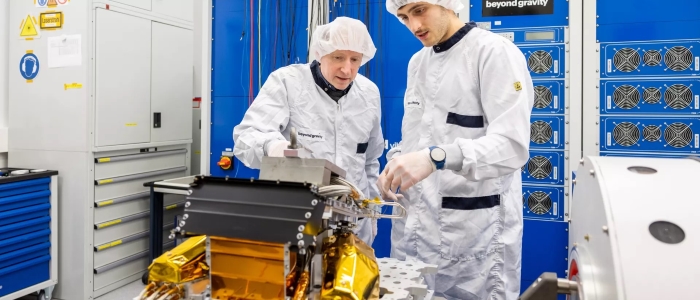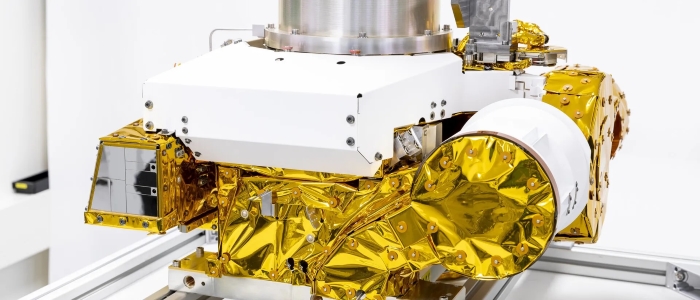How Europe is mastering pointing electric thrusters for satellites

Europe’s major role in the satellite communication sector has continuously grown over the decades, drawing on world-leading expertise from European expertise and competitive solutions. With the support of ESA's Advanced Research in Telecommunications Systems (ARTES) Partnership Projects programme, Beyond Gravity has been able to develop a product family of Electric Propulsion Pointing Mechanisms (EPPMs), and its subsequent next generation called Advanced electric Propulsion Pointing Mechanism (with 2 or 3) Axes (APPMAX).
These EPPMs are developed in Austria, by Beyond Gravity. This key equipment enabled the emergence of the new generation of Europe’s all-electric satellites which dominates the geostationary (GEO) telecommunications sector.
The first evolution EPPMs were deployed for the first time on the Spacebus Neo based Eutelsat KONNECT satellite, launched on 16 January 2020 aboard an Ariane 5 rocket representing another European success story. Eight EPPMs units are since flying on two satcom satellites, with a third flight set expected to fly soon.
The Eutelsat KONNECT satellite, which became fully operational in November 2020 has been providing high-speed broadband services for Eutelsat in Europe and Africa. The Spacebus Neo platform developed under ESA’s Neosat Partnership Programme, jointly managed by ESA and the French space agency CNES, in cooperation with 17 ESA Member States, represents a showcase of ESA’s long-term support to European industry, SMEs and research institutes.
Under the Neosat programme, the Spacebus Neo platform is developed and built by Thales Alenia Space and the Eurostar Neo platform family is developed and built by Airbus Defence and Space.
Telecommunication in GEO has been and still is the largest user of Electric Propulsion (EP). For decades, EP has been used for station-keeping. Today all European Primes offer “all-electric” GEO platforms with EP thrusters and pointing mechanisms.
Telecommunications satellites possess two distinct propulsion requirements: firstly, to raise their orbit up from geostationary transfer orbit up to circular geostationary orbit, some 35,800 km up over the equator. Then, once in position, they need to stay there, by performing regular thruster firings to compensate for gravitational perturbations tugging them sideways.

Improved EPPM designs – including longer articulated thruster arms - are now being incorporated into ESA’s follow-on Neosat programme, developing next generation telecommunications satellite platforms.
This collaboration across ESA Member States, industry champions and involvement of Europe’s growing New Space and SME sector provides a blueprint for future programmes on how to successful unite Europe’s expertise and capability for a more connected and secure world. The Neosat programme has provided participating ESA Member States with a return of over €20 for every €1 invested.
Beyond Gravity’s EPPMs evolved into APPMAX2, selling more than 20 flight units, 2 of which scheduled for a flight opportunity already within 2024. In 2023, an American prime selected Beyond Gravity to provide EPPMs, a huge milestone and showcase in how far European technological capabilities have come. Additionally, the EPPMs were also selected for Thales Alenia Space Italia for the second generation of European Galileo Navigation satellites, in order to deliver the satellites to their exact position and correctly dispose them at end of life. Designed to “minimise mass, isolate the thruster mechanical launch loads, manage orbital temperature extremes and deliver exact pointing accuracy”, this class of mechanisms can position the satellite’s 5 kW plasma thrusters.
As demand for Beyond Gravity’s EPPMs grew, they were contracted to develop bespoke APPMAX3 for GEO satellites. This 3-axis mechanism is being developed for ESA’s Novacom programme, supporting the development of software defined satellites, OneSat for Airbus and Space Inspire for Thales Alenia Space. This innovation builds on the experience developed in APPMAX2 and other ARTES developments, showcasing the technological drive in the European space sector.
“This project is another proud moment for ESA, showcasing that patient investment into a path may not bear instant fruit, but will have a significant benefit along a ten-year timescale,” said Mario Toso, ESA propulsion mechanisms expert.
Beyond Gravity, while thanking ESA continued contribution to their success, proudly explains that “With 100 contracted units in total Beyond Gravity is among the world’s largest manufacturers of pointing mechanisms for electric satellite thrusters. We see especially high demand for our two-axis pointing mechanism product family”, says Dominik Inschlag, Director Marketing & Sales for Thermal & Mechanisms.
The so-called APPMAX2 (2 stands for two-axis) product family ranges from very small mechanisms (the width of a shoebox) to very large electric propulsion pointing mechanisms. For example, Beyond Gravity is building the world’s largest pointing mechanism for electric satellite thrusters. The APPMAX2-Heavy mechanism will be used for the future NASA Gateway space station and will steer a 50-kilogram thruster.
“ARTES Partnership Projects drives European innovation and competitiveness by federating ambitious large-scale and long-term collaborations between ESA, European Industry and satellite operators. Beyond Gravity’s EPPMs success is a vivid example of Partnership Project impact and benefit for European Industry,” said Stéphane Lascar, Head of Satellite Programmes Department for ESA’s Connectivity and Secure Communications.


